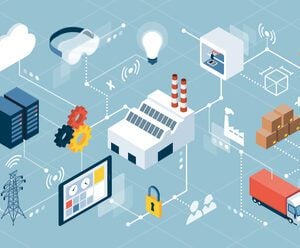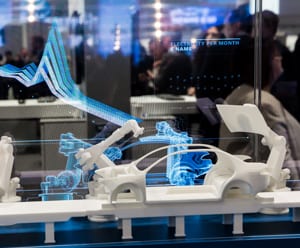
Smartifying Analog Assets to Enhance Logistics

The demand for e-commerce has surged, countered by the tightening of the labor market. Today, it is essential for businesses to be discerning in optimizing their operational efficiency. Companies must bridge the human labor shortage while simultaneously enhancing their networks' agility and resilience.
This is where smartification enters the picture, where existing analog assets are augmented with sensors and wireless technologies. This unlocks a treasure trove of data, transforming static assets into dynamic information hubs.
Imagine a warehouse shelf that monitors its inventory levels or a truck that reports its location and potential maintenance needs in real time. This newfound intelligence empowers data-driven decision-making, propelling logistics into a new era of efficiency and resilience to build smart supply chains.
Smartification: Beyond the buzzword
At its core, smartification boils down to enhancing assets, such as pallets, vehicles and warehouses, with the ability to collect and transmit data. This data can be anything from temperature and location to impact and vibration, providing valuable insights into the shipment’s physical state and journey.
The heart of smartification lies in the creation of digital twins. These virtual replicas of physical assets and systems mirror their real-world counterparts in real time. By integrating data from sensors and intelligent devices, digital twins become powerful tools for simulation, optimization, and risk mitigation.
Consider the creation of a digital twin for an entire logistics network. With it, one can test different scenarios, predict potential bottlenecks, and optimize routes without taking any real-world risks. This foresight empowers businesses to proactively address challenges and ensure seamless operations.
Looking ahead, however, smartification entails so much more than just simulating real-world logistics scenarios and optimizing operations. The technology has the potential to give logistics networks a significant leg-up in mitigating risk.
Anticipating an autonomous future for logistics
The future of logistics goes beyond mere optimization. Envision a scenario where autonomous decision-making allows a logistics network to identify and resolve disruptions on its own.
The network can then automatically reroute deliveries, trigger preventative maintenance, or even activate backup systems. This self-healing capability ensures uninterrupted operations and minimizes the impact of disruptions, leading to a more robust and resilient logistics ecosystem that takes care of itself.
To complement such self-healing capabilities, smartification also entails the use of autonomous robots and vehicles. Drones equipped with AI and sensor technology can conduct inventory checks and deliveries in warehouses. Self-driving trucks can navigate highways with pinpoint accuracy, thus optimizing fuel consumption. These autonomous assets can constantly communicate with each other, optimizing workflows and ensuring efficient task completion, breathing new life into the supply chain.
Beyond building autonomy to anticipate potential errors, smartification also builds supply chains that are decidedly more efficient.
A quantum leap into supply chain efficiency
One of the keys to unlocking this efficiency is quantum computing. This game-changing technology has the potential to revolutionize logistics by analyzing vast amounts of data from countless sensors and devices simultaneously.
Quantum computers can unlock real-time insights for global logistics optimization, enabling supply chains to predict demand fluctuations, identify hidden inefficiencies, and optimize resource allocation with unprecedented accuracy. Its impact on logistics could be as profound as the invention of the container ship.
To boost efficiency, next-generation IoT devices can be equipped with edge computing capabilities to enable real-time decision-making. By enabling such devices to make local decisions instantly, logistics operations will benefit from reduced latency and increased operational efficiency.
For instance, a smart sensor in a truck trailer could detect a temperature fluctuation and automatically adjust the climate control system to ensure the integrity of the cargo. This decentralized approach eliminates reliance on centralized servers, fostering faster reaction times that lead to a more responsive and adaptable supply chain.
Taking a step back from scrutinizing the enhancement of individual assets, smartification can also trigger the massive transformation of the larger logistics ecosystem.
Cultivating intelligence into smart supply chains
Imagine a future where entire warehouses, ports, and transportation hubs are integrated into a single intelligent ecosystem. Cameras, sensors, and embedded AI will orchestrate seamless coordination across the entire supply chain.
Automated loading and unloading systems, along with smart routing algorithms, will streamline cargo movement and optimize facility utilization. These smart environments will increase overall throughput and ensure the efficient flow of goods across the globe.
Predictive maintenance will also prevent unnecessary equipment downtime, and autonomous systems will operate at peak efficiency. This hyper-efficiency will translate into a significant reduction in carbon emissions, minimizing the environmental impact of logistics operations.
Evolution beyond the analog
Beyond the first step of smartifying analog assets, the next generation of smartification will involve embedding intelligence directly into new assets and infrastructure from the design phase. This will create a truly interoperable ecosystem where data flows seamlessly across every component.
Blurring the lines between the physical and digital worlds, this shift will create hyper-connected environments where real-time data informs every decision.
For example, embedded sensors in packaging or even within products could provide granular tracking and condition monitoring throughout the supply chain.
The smartification of logistics is a fundamental shift in how businesses manage the flow of goods across the globe. By embracing these advancements, businesses will empower their supply chains with exceptional levels of efficiency, resilience, and sustainability.
ALSO WORTH READING
















 English
English